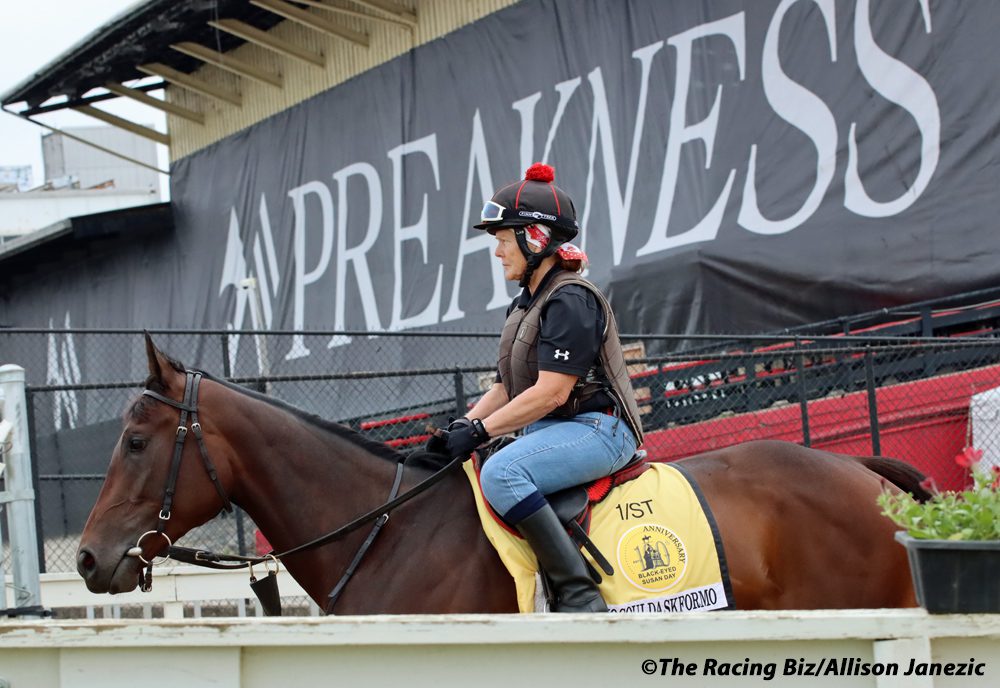MTROA: Pimlico plan may preserve current track layout
Meet the new Pimlico. In one respect, anyway, it may be the same as the old Pimlico.
The Maryland Thoroughbred Racetrack Operating Authority (MTROA) may be about to jettison plans to rotate the racing strip at Pimlico, chairman Greg Cross said at today’s public MTROA meeting.
The original concept of the Pimlico Plus plan to consolidate racing at a new Old Hilltop envisioned not only new barns and new customer-facing facilities but also a new racetrack itself, one rotated 30 degrees from its current configuration and constructed to permit a rapid changeover to a synthetic surface if that becomes necessary.
The call to rotate the track caused no small amount of angst among advocates and history buffs concerned about the alteration of the oval on which Secretariat and Seabiscuit ran. It also came with an enhanced price tag; the design firm Populous estimated the total cost of the project would rise by around $9 million were the track to be rotated because of various ripple effects of the change.
But today Cross told the meeting that the MTROA was “taking a deeper dive” into that question and giving more serious thought to retaining the current configuration.
“That offers several advantages. I mean, obviously it preserves the old track and preserves the history,” Cross explained. “While it will lengthen out somewhat the schematic design process, it actually shortens the build time, because we don’t have to build the track. It acknowledges some community concerns about barns being aligned on Belvedere [Avenue]. When we rotated the track, that’s where they naturally fell, so we don’t have to do it. And it also looks like it would have a substantial effect on construction costs, decreasing them.”
Cross said that not rotating the track appears currently to be a “win-win in all directions” but cautioned that the decision was not written in stone and could be revisited.
The MTROA also gave its formal thumbs-up to a120-day Maryland Jockey Club racing schedule for 2025 previously approved by the state’s Racing Commission. That slate includes 114 days at Laurel Park and six more at Pimlico. It is down from more than 150 days scheduled for this year and 174 in 2019.

The reduced schedule is seen as a way to preserve purse money and avoid conflict with, among other tracks, Colonial Downs. Maryland will be dark for most of Colonial’s summertime meet, and with that track expected to offer some $700,000 in daily purse money, the competition would have been “disastrous,” MTROA consultant Corey Johnsen said. “Both of us would have suffered.”
“It’s the summertime when we have this murderous competition for horses and for the betting dollar that compels a circuit of some sort, and it’s fortunate we are in a position to be able to do that,” added Alan Foreman, the horsemen’s representative on the MTROA.
“This schedule not only ensures year-round access to high-quality racing opportunities for our horsemen in the region but also supports the successful launch of the new non-profit operating entity,” said Katharine M. Voss, President of the Maryland Thoroughbred Horsemen’s Association, in a statement. “It reflects our unwavering commitment to forward-thinking in a rapidly evolving industry.”
“This allows us to study this situation,” Johnsen said. “I’m not here to tell you that this is going to be the schedule in 2026, but we’re going to be so much smarter at the end, or the fall of 2025, on how this works, how we can all work together. And so I think it’s a very important first step.”
From a financial perspective, Johnsen said that the MJC was budgeting for an improved picture in 2025 versus 2024. One positive, he said, was the consolidation of training down to a single facility, Laurel Park, allowing the company to save on track maintenance costs.
Another, he posited, was that the reduction in days should lead to a better racing product more attractive to the wagering public.
“We actually have budgeted a 1% daily increase in wagering,” Johnsen said. The reason we do that is our assumption is reducing dates, there should be an increase in the quality of racing and the quantity of horses running.”
At its current meet, Laurel is averaging a shade under $2.2 million in daily average handle. That’s approximately 17% below 2023 numbers.
The MTROA also received a briefing from attorney Eben Hansel on the status of the operating agreement between the MTROA and the nascent nonprofit that will inherit the Maryland Jockey Club name. The MTROA deferred action on that agreement until December.
LATEST NEWS















